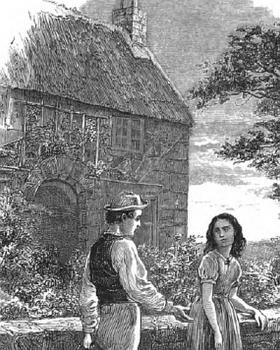Mary, shown in the illustration in front of the Drillot's farmhouse, meets her future grandmother-in-law, a Guernsey farmer's widow, Marion Drillot; Marion's costume is described in detail. By Frances Carey Brock, from her moralistic but entertaining novel, Clear shining after rain: a Guernsey story, in the Library collection, published in 1871.
From the Strangers' Guide to Guernsey and Jersey, Guernsey: Barbet, 1833, pp. 39 ff. 'But it will answer no good purpose for the shell collector in Herm, to employ the language of science, in his research for shells; he must employ popular terms, inasmuch as the good people of Herm are utterly ignorant of the phraseology of the conchologist, and are in the habit of calling things by such names as strike their senses. They have their silver, pink, purple, yellow, rose, and blue shells. There are fine subjects on what the inhabitants call the 'best shell banks,' but which the native collectors pass over, because they do not consider them as shells. For instance, at times here, are very rich corals and corallines, cast up by the action of the sea, only to be discovered by those who are judges of the nature of their research.'
From Sarnia's record in the Great War, published by The Star in 1919.
From George Wearing's A Farmer's Vacation, 1873, pp. 231 ff. The photographs are from the Library collection; that of the Seigneurie in Sark is by Thomas Singleton and dates from c. 1875; above is Baker's Valley in around 1880. 'The population of the island is less than six hundred souls, and of these over ten per cent are confirmed drunkards.'
From Collins' Stranger's Guide to Guernsey, 1833, p. 66.
From Scribner's Monthly Magazine, X (5) September 1873, later collated and published as A Farmer's Vacation.
The Moie de Mouton cave, by a credulous R. Ellis, from the book Rambles among the Channel Islands, by a naturalist, 1854.
The largest cave in Guernsey, once a major tourist attraction. From the Monthly Illustrated Journal, (Guernsey Magazine), October 1888, p. 85; and the cave in 1951, when a party of three including a press photographer go in search of bats there. The illustration is a detail looking out of the Creux Mahie from a small 19th century visitor's guide to the cave.
A cheeky tale, suspiciously similar to Boccaccio's Decameron, from The Stranger's Guide to Guernsey and Jersey, 1833, pp. 128 ff., written by Dr Thomas Bellamy. 'In an old book, now out of print and very scarce, published in 1590, entitled Morgan's Feats of the Cardinals, is the following ludicrous account of the midnight ramble of a gentleman, sent from the island of Guernsey to Naples, in Italy, to buy horses.' The detail is from the frontispiece of the Library's 1566 edition of the Chroniques et Annales de France, Vol. I.
In view of the current controversy over tethering, here is a view of the practice in Guernsey from Duncan's Guernsey and Jersey Magazine in 1836. The woodcut is by Dr Thomas Bellamy from his 1843 Pictorial Directory in the Library Collection.





